Planting Instructions
- Dig a hole that’s a bit larger than the size of the pot.
- Remove the plant from the pot. You may have to cut the pot from the bamboo plant if it doesn’t slide out easily.
- Set the plant in the hole so that the soil with the plant is even with the level of the existing soil.
- Backfill with existing soil mixed with a rich topsoil or manure compost. Make sure that there are no air pockets around the root ball.
- Water well and often but do not keep your bamboo's roots constantly submerged in a boggy swamp . Good drainage is important - deep waterings, no standing water after a few hours, is your goal. If the leaves start to curl, your bamboo is not getting enough water. If the leaves stay open but the majority are yellow, the roots may be drowning and rotting. This is rare - not enough water during establishment is, by far, the most common problem. You will have to water daily for at least a month to insure the roots become established in the existing soil. Tropical bamboos are among the easiest plants to grow so you should have no problems.
- Add mulch around your bamboo and always maintain a good layer of mulch. Fertilize every three or four months with a palm or bamboo fertilizer.
Maintenance / Care
There are four conditions that optimize the growth of tropical bamboos: Sunlight, regular irrigation, good drainage, and at least occasional fertilization. If any of these conditions is lacking, the growth rate will be affected in direct proportion to the deficiency. You can certainly have a beautiful bamboo, but again, the growth rate will not be maximized.
SUNLIGHT
Most tropical bamboos grow quicker and do their best in full sun. As long as at least four hours of sun reaches the leaves, your tropical bamboo will be happy. If grown in broken light or partial sun, the number of shoots per year will not be as high as if it were in full sun. Some tropical bamboo species will stretch - elongating its internodes - if grown under the canopy of another tree in an effort to reach the sun. These bamboos have culms that have been measured much longer than their standard ABS listing.
WATERING
When you first plant your bamboo you will need to make sure that it has enough water every day for at least a month or so. This means you may have to hose soak it if you irrigation system only hits the area every other day or less often. Even if your irrigation system covers the area daily, watch the leaves of your new bamboo. If they start to curl, the bamboo needs more water. This is easily the number one problem reported by new growers. I certainly don’t want you to keep your bamboo in standing water but please make sure it gets off to a good start with a bit of early watering diligence.
DRAINAGE
The most important part of your bamboo plant is under ground. The rhizome and root system will not survive if planted in muck or boggy conditions. Good drainage is important. If necessary, build up a small berm and plant in this area so that excess water can drain into lower areas.
FERTILIZING and MULCH
Tropical Bamboo Nursery now is offering our own Bamboo Fertilizer in 2 lb. jars. This is a timed-release mix that we use in containers as well as for field specimens. New bamboos can be fertilized with a balanced lawn or, especially, palm fertilizer. After the first year, higher nitrogen formulas can be used. Iron supplements are beneficial. If your soil is somewhat alkaline (as in South Florida), there are many sulphur/iron mixes (granular or liquid) that work well and show favorable results quickly. Don’t use a weed-n-feed lawn fertilizer.
Compost and mulch are the easiest way to maintain healthy soil and bamboos. If your mulch is fresh and uncomposted, fertilize before mulching. The microorganisms that break down the mulch will rob the nitrogen from the soil so you’ll have to feed them as well as the bamboo.
PRUNING
After the second year you can remove some of the original growth. Do
not
take more than 1/3 of the culms. Cut out only the old culms (usually
the smallest in the clump). Cut them near the ground (or just below ground to eliminate any small stumps). If a
culm is tan, it’s dead and should be removed. We use a small handsaw or a reciprocating saw. You can thin the clump each year. Avoid removing
the newest culms unless they are growing awkwardly or into an unwelcome area.
You can also remove or shorten branches to reveal the canes or to create a more
open effect. I do this with all of my low-branching species as a personal
preference.
For more detailed instructions, please see: Bamboo Trimming & Maintenance
If you’re planting several bamboos to create a screen, hedge, or windbreak, the spacing will vary depending on the species, density required, and the speed required for establishment. Tropical bamboos can be planted as close as 3 feet on center but 5 feet on centers is the average spacing.
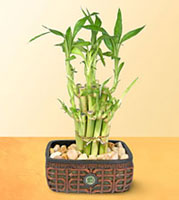 How do I care for my bamboo that grows in water & pebbles (Lucky Bamboo)?
How do I care for my bamboo that grows in water & pebbles (Lucky Bamboo)?
The popular "lucky bamboo" plant is technically "dracaena sanderia," - a lily, not an actual bamboo plant. It is a houseplant that is most often rooted in water and supported by pebbles. We only grow tropical bamboos and can only offer expert advice on our specialty. Real tropical bamboos cannot survive if planted in water, or even with constant wet feet. Ours are landscape ornamentals that grow relatively large, depending on the species, and are happiest if planted outdoors.
Are there any pests or diseases that infest or infect tropical bamboo plants?
Tropical bamboos are less susceptible to pests or diseases than most other tropical plants. However, there are a couple of pests, a fungus, and a virus that, in the U.S., may be introduced to you in conversation or you may suspect on your tropical bamboo plant. Most are not fatal and usually don't greatly affect the growth of the bamboo. We, and our local Plant Industry inspectors, monitor our stock to ensure that no problems originate at our nursery.
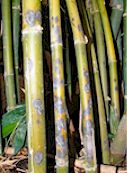 Fungal spots - On older culms, especially in humid conditions, fungal
spots
can appear - usually in a circular ring pattern. The effect is mostly
cosmetic. This can be treated topically with a copper-based product
that's
labeled for plant fungus problems. Alternatively, since the affected
culms
are usually old, the culm(s) can be simply removed from the clump.
Fungal spots - On older culms, especially in humid conditions, fungal
spots
can appear - usually in a circular ring pattern. The effect is mostly
cosmetic. This can be treated topically with a copper-based product
that's
labeled for plant fungus problems. Alternatively, since the affected
culms
are usually old, the culm(s) can be simply removed from the clump.
We have written a blog on subject of Bamboo Culm Discoloration. The fungal spot issue is covered in this article.
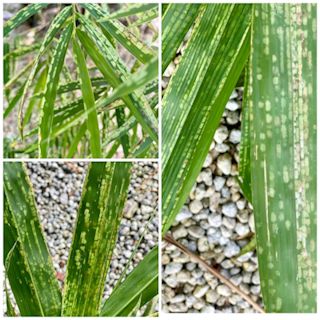 Bamboo Spider Mites - Spider mites used to be more commonly associated with temperate, running bamboos in the USA.
For decades, tropical bamboos in were mostly planted as single ornamental specimens and didn't provide the density preferred by mites.
Bamboo Spider Mites - Spider mites used to be more commonly associated with temperate, running bamboos in the USA.
For decades, tropical bamboos in were mostly planted as single ornamental specimens and didn't provide the density preferred by mites.
Since tropical, clumping bamboos are now being utilized as privacy screens and are becoming popular in private jungle landscapes and food forests, the mites have noticed. They are now targeting some of these tropical bamboo species.
Like other bamboo pests, the damage is mostly cosmetic. The leaves will show irregular yellow spots where the mites have pierced and sucked out the leaf juices. You may see some webbing on the undersides of some of the leaves.
Spider mites are active during hot, dry summer months. They become mostly dormant in fall and winter. You can treat them with biological controls (predatory mites),
with natural miticidal sprays (neem oil, pyrethrins), or with a systemic miticide like Abamectin.
Since Abamectin is a natural fermented product, it could be considered a natural control.
Also, it's possible to use predatory mites IN CONJUNCTION with Abamectin. The predators do not eat the bamboo that has been sprayed, only other mites and aphids, so the predators won't be killed by the Abamectin.
The predatory mites that seem to work best on bamboo mites are:
Neoseiulus (Amblyseius) fallacis,
Neoseiulus (Amblyseius) californicus,
and
Amblyseius cucumeris.
The treatments, applied as directed, will take care of the bamboo mites. The damaged leaves won't heal so you might think the mites are sill around. Since bamboo leaves do cycle quickly, the damaged leaves will eventually drop off and new, undamaged leaves will replace them. You can also trim off the most visibly damaged leaves to encourage new growth.
Please follow the application instructions for whatever treatments you use. We cannot calculate mix rates or predator mite quantities for you.
Black Sooty Mold - this is probably the most common issue
reported
on tropical bamboos. In South Florida, the B.multiplex varieties are
most
susceptible. Any bamboo species with dense branch compliments at the
nodes
are good candidates. The problem is caused by aphids that secrete a
sticky
honey-like substance that accumulates mostly in the branch bases. The
sooty
mold grows on this secretion. Ants favor the secretion and will farm
the
aphids, moving them around to other parts of the bamboo. Treat with
garden
center products labeled for control ants and/or aphids. You can also
use a
pressure washer to blast off the mold.
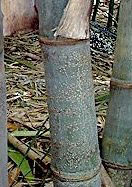 Scale - This is often ignored by growers as it can be difficult to
notice.
It can, however, become so dense that it can completely cover culms in
a
clump, changing the color to brownish/gray. Regardless, the bamboo
never
seems to notice their presence so treatment is often a matter of
personal
preference. Scale affects many of the Bambusa species as the culm are
glabrous. Some of the Dendrocalamus, like giganteus, are also
favorites.
Scale are tiny sucking insects with waxy-coverings on their backs. They
must
be either removed physically or treated systemically. Contact
insecticides
are ineffective because of the waxy shield. If systemic insecticides
(insecticides that are absorbed into the plant tissue and consumed by
the
sucking insect) are used, the dead bugs will remain attached to the
culm,
branch, or leaf. It's easy to blast them off the culms, dead or alive,
with
a pressure washer. Use garden center systemic products labeled for
scale.
Insecticidal oils and soaps may be effective but must be applied at
more
frequent intervals.
Scale - This is often ignored by growers as it can be difficult to
notice.
It can, however, become so dense that it can completely cover culms in
a
clump, changing the color to brownish/gray. Regardless, the bamboo
never
seems to notice their presence so treatment is often a matter of
personal
preference. Scale affects many of the Bambusa species as the culm are
glabrous. Some of the Dendrocalamus, like giganteus, are also
favorites.
Scale are tiny sucking insects with waxy-coverings on their backs. They
must
be either removed physically or treated systemically. Contact
insecticides
are ineffective because of the waxy shield. If systemic insecticides
(insecticides that are absorbed into the plant tissue and consumed by
the
sucking insect) are used, the dead bugs will remain attached to the
culm,
branch, or leaf. It's easy to blast them off the culms, dead or alive,
with
a pressure washer. Use garden center systemic products labeled for
scale.
Insecticidal oils and soaps may be effective but must be applied at
more
frequent intervals.
Bamboo Mealybug (Palmicultor lumpurensis) - This is a bamboo-specific
mealybug so it should not affect other plants. It was first officially
reported in 2002 in Central Florida http://www.freshfromflorida.com/content/download/9805/135098/palmicultor-lumpurensis.pdf.
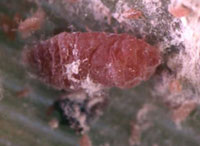 The mealybugs are multi-stage insects and are easily identified when they are surrounded by sticky white webbing - almost always on new shoot tips (culm tips or branches). If you see unusual white substance on shoot tips, peel back the culm leaves and you should see small pink bodies in the webbing or on the culm. Sometimes natural white powdery bloom on the new shoot can appear to be the webbing but is a false alarm. Make sure you look for the bugs before making an assumption of infestation. Usually the bamboo shoots develop with no adverse affects. Occasionally, the infestation is so severe that the culm, or culms, abort. Mealybugs won't kill a clump of bamboo but they can get ugly and possibly cause shoots to abort.
The mealybugs are multi-stage insects and are easily identified when they are surrounded by sticky white webbing - almost always on new shoot tips (culm tips or branches). If you see unusual white substance on shoot tips, peel back the culm leaves and you should see small pink bodies in the webbing or on the culm. Sometimes natural white powdery bloom on the new shoot can appear to be the webbing but is a false alarm. Make sure you look for the bugs before making an assumption of infestation. Usually the bamboo shoots develop with no adverse affects. Occasionally, the infestation is so severe that the culm, or culms, abort. Mealybugs won't kill a clump of bamboo but they can get ugly and possibly cause shoots to abort.
 The mealybug destroyer(Crypt)
Beneficial predatory insects can be effective at least short-term. The mealybug destroyer (Crypts) especially loves these mealybugs and will quickly eat any active colonies. Crypts can be ordered from many online sources. The problem is that mealy bugs are multi-stage and the Crypts only stay around as long as there is live food (not eggs). As soon as the Crypts leave, new mealys hatch and you may have to buy more Crypts. In November/2006, I spoke by telephone with Dr. Greg Hodges (see link above on first report) and asked him if there was anything new since his report. He told me that in 2004 the original infestation at the Lake Buena Vista, FL location was severe and that, strangely, without chemical treatment, the condition seemed improved in 2005. By 2006, there were only minimal signs of mealybug but close inspection revealed colonies of ladybeetles (Cryptolaemus montrouzieri - Crypts or Mealybug Destroyers). I don't know yet if the Crypts were manually introduced or just naturally appeared but the situation appears to have been balanced at this location. Dr. Hodges also said that, when he first wrote his report, he could find very little published reference data worldwide on this bamboo mealybug. He thought that might have meant Palmicultor lumpurensis was not considered to be much of a threat in the countries where it has been established.
The mealybug destroyer(Crypt)
Beneficial predatory insects can be effective at least short-term. The mealybug destroyer (Crypts) especially loves these mealybugs and will quickly eat any active colonies. Crypts can be ordered from many online sources. The problem is that mealy bugs are multi-stage and the Crypts only stay around as long as there is live food (not eggs). As soon as the Crypts leave, new mealys hatch and you may have to buy more Crypts. In November/2006, I spoke by telephone with Dr. Greg Hodges (see link above on first report) and asked him if there was anything new since his report. He told me that in 2004 the original infestation at the Lake Buena Vista, FL location was severe and that, strangely, without chemical treatment, the condition seemed improved in 2005. By 2006, there were only minimal signs of mealybug but close inspection revealed colonies of ladybeetles (Cryptolaemus montrouzieri - Crypts or Mealybug Destroyers). I don't know yet if the Crypts were manually introduced or just naturally appeared but the situation appears to have been balanced at this location. Dr. Hodges also said that, when he first wrote his report, he could find very little published reference data worldwide on this bamboo mealybug. He thought that might have meant Palmicultor lumpurensis was not considered to be much of a threat in the countries where it has been established.
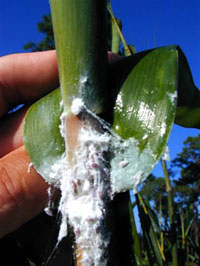 "Systemic and contact insecticides are effective and there are several
available at garden centers labeled for mealybugs. A detergent (Ivory
dish
soap is great) should be added as a surfactant if you foliar spray with
a
contact insecticide as the webbing is difficult to penetrate with a
water-based solution. The key is to thoroughly spray your bamboo - all
sides, top to bottom. Don't miss any part of the bamboo and spray out
to the
drip line on the ground. Then re-apply every 10-14 days for at least
three
cycles. Do this even if you don't see any new mealys that have hatched.
You
have to break the cycle. If you spray once or twice and think you've
eliminated the problem, new bugs will appear in a few weeks to taunt
you."
"Systemic and contact insecticides are effective and there are several
available at garden centers labeled for mealybugs. A detergent (Ivory
dish
soap is great) should be added as a surfactant if you foliar spray with
a
contact insecticide as the webbing is difficult to penetrate with a
water-based solution. The key is to thoroughly spray your bamboo - all
sides, top to bottom. Don't miss any part of the bamboo and spray out
to the
drip line on the ground. Then re-apply every 10-14 days for at least
three
cycles. Do this even if you don't see any new mealys that have hatched.
You
have to break the cycle. If you spray once or twice and think you've
eliminated the problem, new bugs will appear in a few weeks to taunt
you."
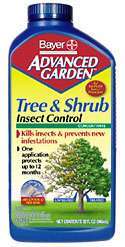 The most-effective treatment to date for homeowners is one of the Bayer
Advanced Tree & Shrub products. These are available at most garden
centers
and home improvement stores. They are applied simply by drenching the
root
zone or by spreading slow-release granules around the root zone. If you
can't find these specific products, look for a similar product that
contains
the active ingredient imidacloprid which is a synthetic form of
nicotine.
The most-effective treatment to date for homeowners is one of the Bayer
Advanced Tree & Shrub products. These are available at most garden
centers
and home improvement stores. They are applied simply by drenching the
root
zone or by spreading slow-release granules around the root zone. If you
can't find these specific products, look for a similar product that
contains
the active ingredient imidacloprid which is a synthetic form of
nicotine.
On a commercial scale, or for a bamboo-hobbyist with a large collection, the formula below is thoroughly effective in eliminating and preventing any mealybugs (and most other sucking insects). These products are not yet labeled for use on bamboo plants (although they are labeled for mealybug control on other plants). That means I'm only providing information on what works for me, not suggesting anyone follow my experimental formula. I do not assume any product liability:
Different tank mixtures, rotated every 2 months:
1) (Dinotefuran) Safari together with Joint Venture surfactant (or Ivory dish detergent) in the spray tank. The Safari is mixed with 50 gallons of water at 5 oz. total. I mix in 8 oz. of Joint Venture. I also mix in Tracite 20-20-20 water-soluble fertilizer to provide some nutritional benefit for the bamboos. Soak the infested bamboo top to bottom - especially the shoots and branch shoots. Make sure the inner culms are covered as well. You have to re-apply after 14 days to make sure any new hatchlings are zapped.
2) (Buprofezin) Talus, which interrupts the larval stage of the growth cycle. This comes in bags containing 24 water-soluble pouches. One pouch per 10 gallons. Dimethoate (Cygon) can be mixed in at 16 oz. per 50 gallons. Joint Venture surfactant 8 oz. Per 50 gallons (or Ivory dish detergent). No fertilizer is added to the tank with Talus because it is labeled to not be mixed with boron, chromium, or other micronutrients.
The Safari treatment seems most powerful immediately as a systemic control but it is important to rotate insecticides. Obviously, take measures to prevent getting any of this stuff on your skin or in your lungs.
BaMV (Bamboo Mosaic Potex Virus) - When bamboo growers in the USA ask send us photos asking if their bamboo is infected with BaMV our first response, without even looking at the photos, is "it's doubtful". This is simply not a common bamboo disease in the USA.
All legally imported bamboos are checked for BaMV while in quarantine for more than two years.
It is a fairly rare virus that is transmitted
only by physical vectors (usually cutting tools). It is actually difficult
to transmit but people do manage to spread it - especially in countries where
bamboo is grown in plantations for edible shoots. Reputable ornamental
growers do not freely distribute infected plants so you should
never encounter this disease. Of course, if you illegally import bamboo plants or seeds these's a chance you'll be introducing the virus.
